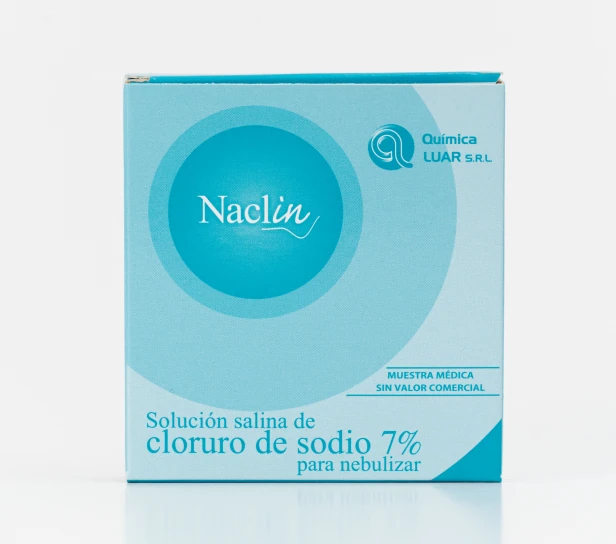Naclin
First 7% saline solution approved in Argentina
It is a hypertonic solution of sodium chloride for nebulization, recommended as a coadjuvant treatment for cystic fibrosis, as a symptomatic treatment to facilitate mucociliary clearance and fluidification of pulmonary secretions. It acts by favoring the elimination of mucus from the respiratory tract and increasing ciliary movement.

Emergence of the product
In August 2007 the
Cystic Fibrosis Foundation
asked the University of California to conduct a review to evaluate the background of published clinical studies on the different therapies used in the treatment of Cystic Fibrosis. In a report published on the subject, the Foundation recommends the chronic use of inhaled hypertonic saline to improve lung function and reduce exacerbations of the disease. The evaluation committee found evidence that the results obtained with the use of these hypertonic solutions are conclusive and that the advantages of this treatment outweigh its potential harms. (1)

Given the existing history of the use of concentrated saline solutions as improvers of mucociliary clearance (one of the main disorders caused by this pathology), and the recommendations of the Cystic Fibrosis Foundation, and taking into account that in the current pharmaceutical market there is no saline solution presentation in the adequate concentration for this treatment, Química Luartook on the challenge of designing, developing and manufacturing Naclín, a product containing a 7% sodium chloride solution for nebulization.
Frequently Asked Questions
Each 5 ml ampoule of Naclin inhalation saline solution contains 350 mg of sterile, non-pyrogenic sodium chloride, presented in boxes containing 30 and 60 units.
Hypertonic saline is used by nebulization twice daily in people with Cystic Fibrosis over six years of age to help increase their lung function and decrease the number of lung infections. It can also help to reduce the thickness of mucus in the airways of a person with Cystic Fibrosis.
Nebulizations with 7% saline solution prior use of a bronchodilator have proven to be effective, safe and economical and are presented as an additional therapy for short and long term use in patients with Cystic Fibrosis lung disease.
Why a 7% solution?
Robinson et al in a prospective randomized clinical trial compared different concentrations (3%, 7% and 12%) of nebulized hypertonic saline demonstrating a significant difference in favor of the higher concentration saline. They also reported that there were no significant differences between the 7% and 12% saline solution, with the 7% concentration being the most effective. (2)
Who would be the potential beneficiaries of Naclin’s administration?
The Cystic Fibrosis Foundation recommends this treatment for any patient 6 years of age and older or patients who have a forced expiratory volume in 1 second (FEV 1) equal to or greater than 40%. (1)
How should Naclin be used?
Hypertonic saline solution proved to be a useful tool in daily care for Cystic Fibrosis. It was not designed with the intention of replacing other treatments, but rather to complement each patient’s regular treatment.
The 7% saline solution acts as a mucolytic and secretion fluidizing agent, since by fluidizing the thick mucus it increases the thickness of the liquid layer of the airway, facilitating the movement of the cilia, the transport of mucus and stimulates coughing.
It also accelerates mucociliary clearance, increases the effectiveness of kinesiotherapy, reduces the frequency of exacerbations and improves lung function.
What is the formula?
Each 5 ml ampoule of Naclin (7% sodium chloride solution) for nebulization contains:
Sodium chloride…………………………………350 mg
Water quality for injection csp……………………5 ml
Naclin is presented as a clear, sterile, non-pyrogenic, aqueous solution with pH and salinity adjusted specifically for administration with a reusable compressed air driven nebulizer. It should be noted that the formulation is useful only in INHALATIONS WITH NEBULIZER.
How do concentrated salt solutions work?
It has been shown that 7% sodium chloride saline improves mucociliary clearance in vitro and causes a reduction of the destructive inflammatory process in the airways in short-term trials. (2), (3).
Concentrated saline solutions act on the surface of the airways in different ways:
-breaking the ionic bonds within the mucous plug which reduces the degree of cross linking and decreases its viscosity and elasticity.
-provoking an osmotic flow of water in the mucus layer which rehydrates the secretions and improves their rheology.
-In chronic infections, the mucin of the mucous plug develops fixed negative charges that would be causing a greater repulsion. Concentrated salt solutions act by generating a conformational change by reducing repulsion, generating a more compact macromolecule of mucus resulting in more effective clearance.
What is the dose of Naclin to be administered?
A review of clinical trials found that a total volume of 10 ml of concentrated 7% sodium chloride solution, administered in two to three nebulizations daily, helps clear mucus without significant adverse effects. (4)
What are the main adverse effects?
The following adverse effects associated with treatment with concentrated saline solution for nebulization have been reported: cough, pharyngeal irritation, pharyngitis, throat inflammation, chest tightness and acute bronchospasm, which diminish or disappear with repeated use of the drug.
Inhalation of concentrated saline solution may cause an unpleasant taste in the patient’s mouth, which can be reduced by rinsing the mouth with water.
It has also been reported that the use of saline solution for nebulization did not affect the type of bacteria present in the lungs or their concentration in mucus. (4), (5).
What precautions should be taken in its use?
Concentrated saline solutions may irritate the respiratory tract, so it is recommended that each patient take his or her first dose in a health care facility, in the presence of a professional who will evaluate tolerance to the solution. (4)
It has also been reported that concentrated saline solutions, having an osmolarity different from that of the airway, can cause irritation and consequently bronchoconstriction immediately after nebulization. Therefore, the use of a bronchodilator (e.g., salbutamol) prior to nebulization with Naclin is recommended.
Inhalation of concentrated saline does not cause inflammation and there is no clear evidence about the benefit of its use in the treatment of other pulmonary diseases.
Can concentrated saline solutions interact with other drugs administered at the same time?
No drug-drug interactions of 7% saline with other drugs or acute or chronic toxicity events have been reported in the literature. No problems related to its use during pregnancy and lactation have been reported.
Is there a history of its therapeutic efficacy?
Recently, the Cystic Fibrosis Foundation funded a study in Australia to find out if inhaling the concentrated saline solution twice a day would help people with cystic fibrosis.
The study participants were divided into two groups. One group inhaled normal saline with a concentration of 0.9% and the other group inhaled saline with a concentration of 7%.
Both groups used a bronchodilator and then inhaled these solutions using a nebulizer, twice a day for one year. During the study, patients were closely observed for any health problems or improvements while inhaling their assigned solution.
Both groups of patients exhibited improved lung function during the study, however those who inhaled the 7% saline exhibited a significant improvement in lung function over those who inhaled normal saline. It was also found that those administered 7% saline solution had fewer lung infections than the other group. Patients who inhaled 7% saline reported better attendance at school, work and other usual activities and felt generally better in both health and quality of life. (6), (7), (5).
We can conclude that:
Concentrated saline solutions, including Naclin, act by restoring hydration and airway volume, which leads to an increase in mucociliary clearance and improved pulmonary function.
Nebulizations with 7% saline solution, prior use of a bronchodilator, have proven to be effective, safe and economical and are presented as an additional therapy for short- and long-term use in patients with Cystic Fibrosis lung disease.
Bibliographic Sources:
(1) Flume P. et al. Cystic Fibrosis Pulmonary Guidelines: Chronic medications for maintenance of lung health Published in AJRCCM, August 29, 2007.
(2) Wark PAB, McDonald V, Jones AP. Nebulized hypertonic saline solution for cystic fibrosis. (Cochrane Review). In The Cochrane Library Plus, Issue 4, 2007. Oxfor: Update Software.
(3) Betancur D.F., Baez J., Reyes M., Sussini M. Use of inhaled hypertonic saline solutions to restore surface airway hydration in patients with cystic fibrosis. Revista de Postgrado de la VI Cátedra de Medicina, December 2006, N° 164. P. 13-16.
(4) Hypertonic saline solution. Available at www.fibrosisquistica.org.ar/novedades-pacientes.php, March 4, 2008.
(5) Bye P. Hypertonic saline research. Available at www.cfww.org.
(6) Elkins M. et al. A controlled trial of long-term inhaled hypertonic saline in patients with cystic fibrosis. The New England Journal of Medicine, January 2006. Vol. 354, No. 3.
(7) Hypertonic saline solution. Available at www.cff.org. May 2008.
(8) Cunningham J, Taussig L. An introduction to cystic fibrosis for patients and their families. Cystic Fibrosis Foundation. 2003, 5th ed. Ed.
